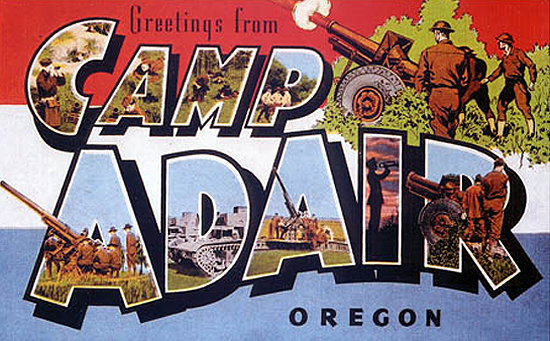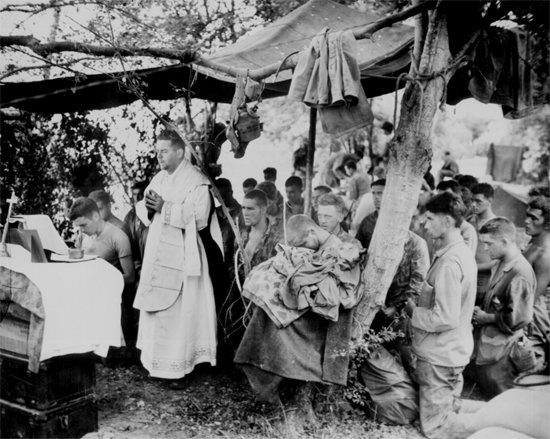Veteran’s Testimony – Floyd C. Freeman 370th Medical Battalion

Photograph of T/5 Floyd Freeman, taken during his time in Kessel, Germany. September 1945
Introduction:
The following story was received from T/5 Floyd Calvin Freeman (ASN: 37906470), who served with the 370th Medical Battalion as the Chaplain’s Assistant. He kindly forwarded details about his service following an Article in the 70th Infantry Division Association’s newsletter “Trailblazer” about the WW2 US Medical Research Centre. It is reproduced here with the kind permission of Floyd; it was originally entitled “How I Won World War II”:
Assignment:
In August, 1944 I was stationed in Ft. Leonard Wood, Rolla, Missouri (Engineer RTC & Division Camp) and was in I Company of the 275th Infantry Regiment, 70th Infantry Division. I had been in Camp Adair, Corvallis, Oregon for a year before we went to Missouri.

A greetings postcard from Camp Adair, Oregon.
The 275th Infantry Regiment was one of the three organic Infantry units (274th + 275th + 276th Infantry Regiments) pertaining to the 70th Infantry Division. The Regiment was activated at Camp Adair, Corvallis, Oregon, 15 June 1943 and immediately assigned to the “Trailblazers” (activated the same date and at the same place). It moved to Fort Leonard Wood, Rolla, Missouri (ERTC & Division Camp), 29 July 1944, and subsequently staged at Camp Myles Standish, Boston, Massachusetts, 19 November 1944, before leaving for overseas on 6 December 1944 (departed from Boston Port of Embarkation). We reached France 15 December 1944.
The next morning I was called into the office as a Chaplain wanted to talk to me. This was Chaplain Ronald E. Hubbard from the 370th Medical Battalion. The Chaplain’s main function was to administer the spiritual needs of casualties evacuated from the Division and Battalion personnel. His duties mostly required his presence at the Clearing Station, since this was the place through which all casualties had to pass. He was assisted in his duties by an Enlisted Man. I was subsequently transferred out of the Infantry and was now a medic, being the Chaplain’s Assistant. A Medical Battalion was an organic element of a Division developed to provide medical support for the Infantry. A per T/O 8-15, dated 1 April 1942, it consisted of 34 Officers and 470 Enlisted Men. One Chaplain (an additional Officer) was attached to the Battalion. My new unit’s main organization was as follows: 1 Battalion Headquarters, consisting of Headquarters & Headquarters Detachment – 3 Collecting Companies; A Company (Collecting), B Company (Collecting), C Company (Collecting) – 1 Clearing Company; D Company (Clearing) – and a total of 79 vehicles and 21 trailers.
Overseas – France:
We went to France a month after the Infantry Regiments sailed for Europe. When we got into the battle area, a “Chaplain’s Kitchen” was set up for me. Every day a large truckload of French bread was delivered to me and it was stacked like wood in the back of my working table. I had many 5 gallon drums of peanut butter and strawberry jam in the kitchen. It was now my job to cut the French bread in slices, be very generous with the peanut butter and jam and make open faced sandwiches. I served them from a large tray to the wounded men, the American soldiers as well as to the German prisoners who had been hurt. The Government told me when I asked why we did not serve a good bowl of hot soup that this would make men sick, as they had been eating only C or K rations, and the bread with peanut butter and jam was most healthy and probably too heavy on their stomachs.

With a canvas tarpaulin for a church and packing cases for an altar, a Navy chaplain holds mass for Marines at Saipan. The service was held in memory of brave buddies who lost their lives in the initial landings. 15 June 1944.
This was my daily job, when we were not out in the field attending church services. I was working making the sandwiches 24 hours a day. When I was giving them to the wounded men I asked about my friends in I Company, 275th Infantry, and was told that many had been killed or captured or were in bad shape with Trench Foot. Finally I told the Chaplain that Infantry replacements were needed, and since I was a qualified Infantry soldier, I asked him whether he would release me from my job so I could go to the front. He took me downstairs to a small room in the school at St. Avold, France that we had converted into a hospital. He locked me in the room and told me to go to sleep and rest. Later he returned and had a long talk with me, explaining to me that I had the most important job in the US Army and should stay and continue making the peanut butter and jam sandwiches.
I know that God was watching over me, and I am alive today because I stayed with my job as a Chaplain’s Assistant.
I participated in the following World War 2 campaigns: Rhineland, Ardennes-Alsace, and Central Europe. The 70th Infantry Division returned to the Zone of Interior, arriving at the New York Port of Embarkation 9 October 1945, and was finally inactivated at Camp Kilmer (Staging Area), Stelton, New Jersey, 11 October 1945.
“Yes, I still like peanut butter and jam sandwiches.”
Floyd also provided the following information about his life following WW2.
“I have been a travel agent for 40 years, and have arranged and escorted our 70th Infantry Veterans on 16 Return-to-Europe tours.”
Unless otherwise stated, and except for a few editing remarks, all texts in this testimony are courtesy of T/5 Floyd C. Freeman (ASN:15359023), who was an active member (Chaplain’s Assistant) of the 370th Medical Battalion in WW2. The MRC staff are truly thankful for sharing his personal reminiscences with them.
